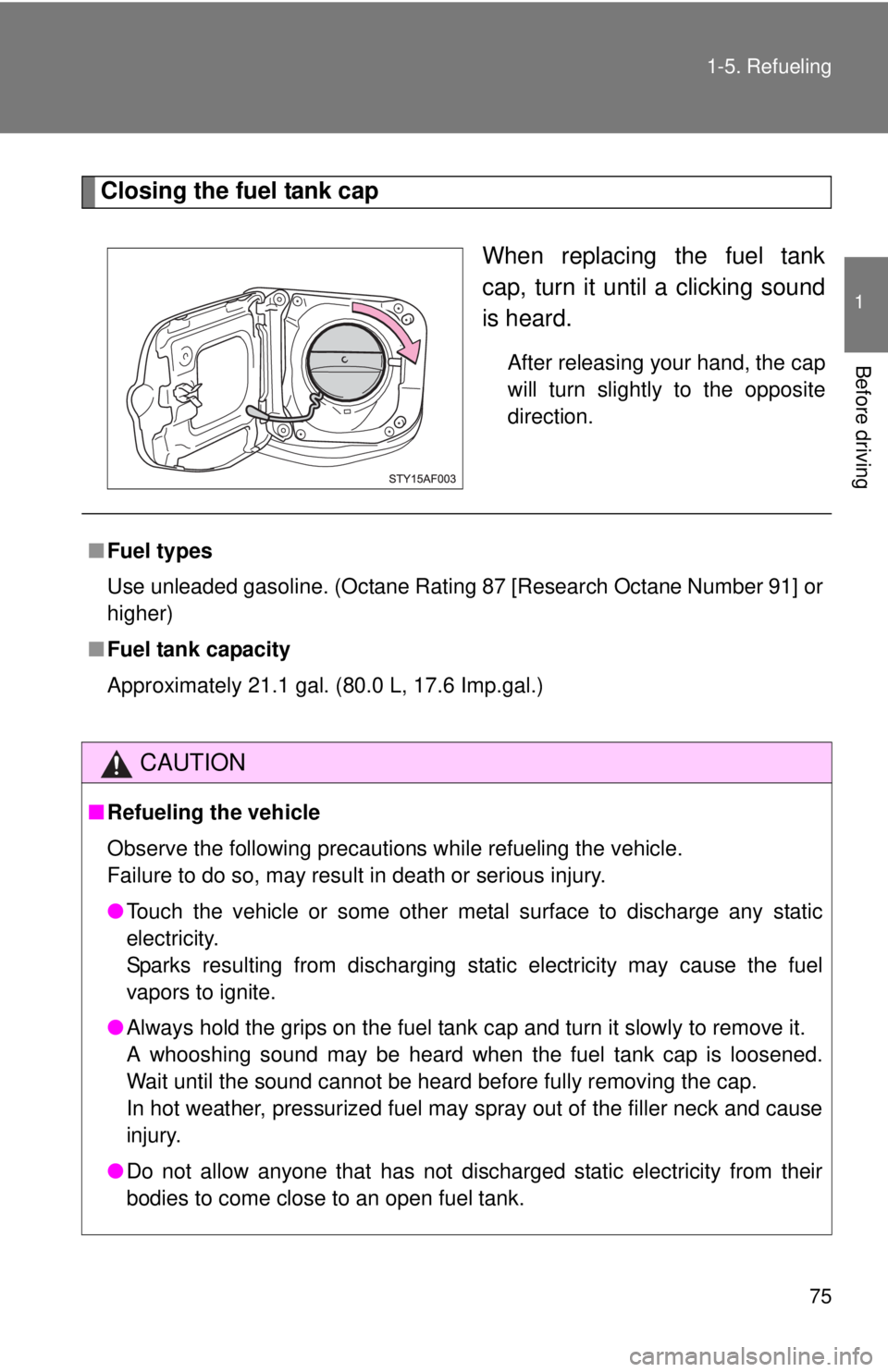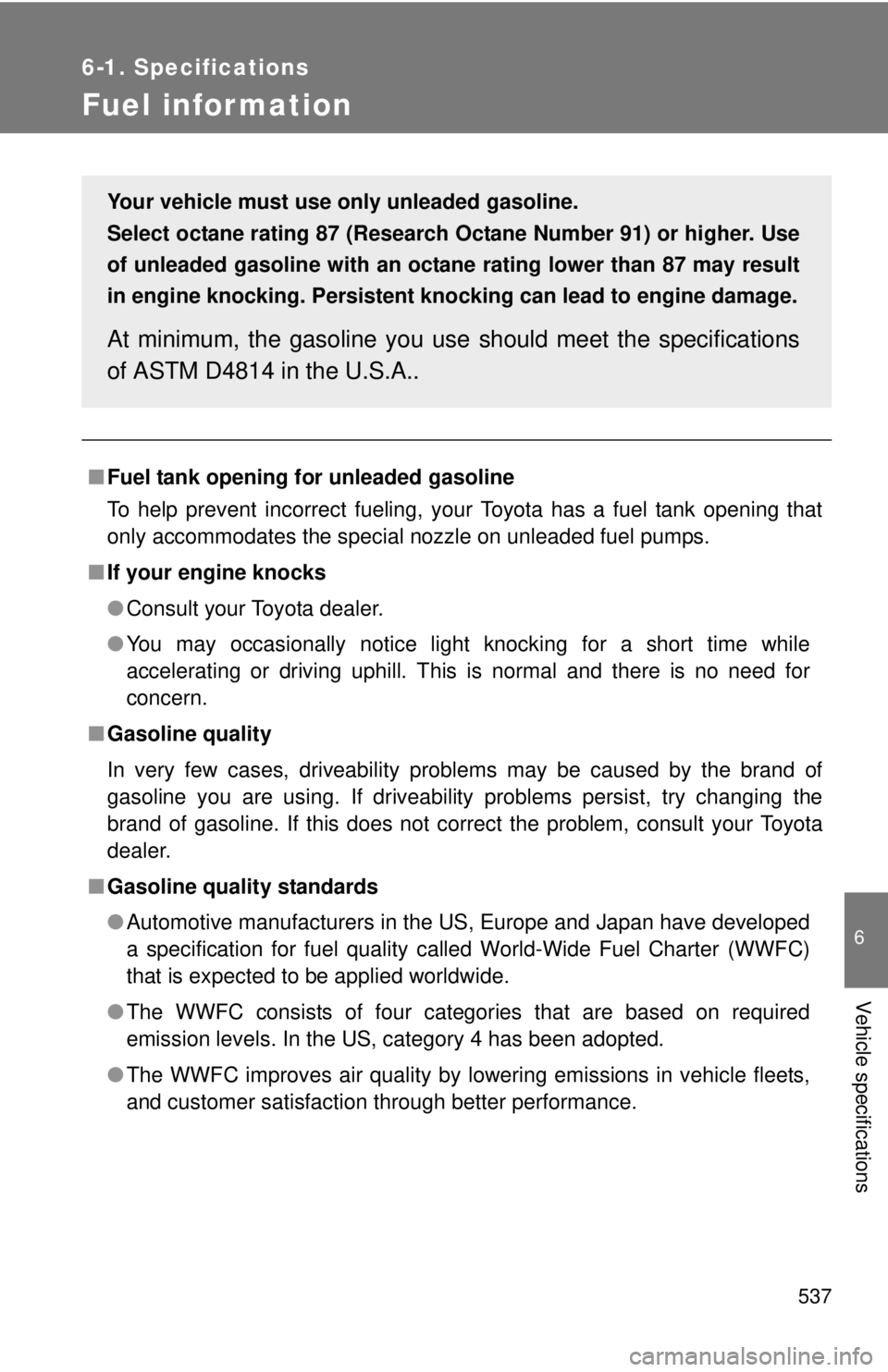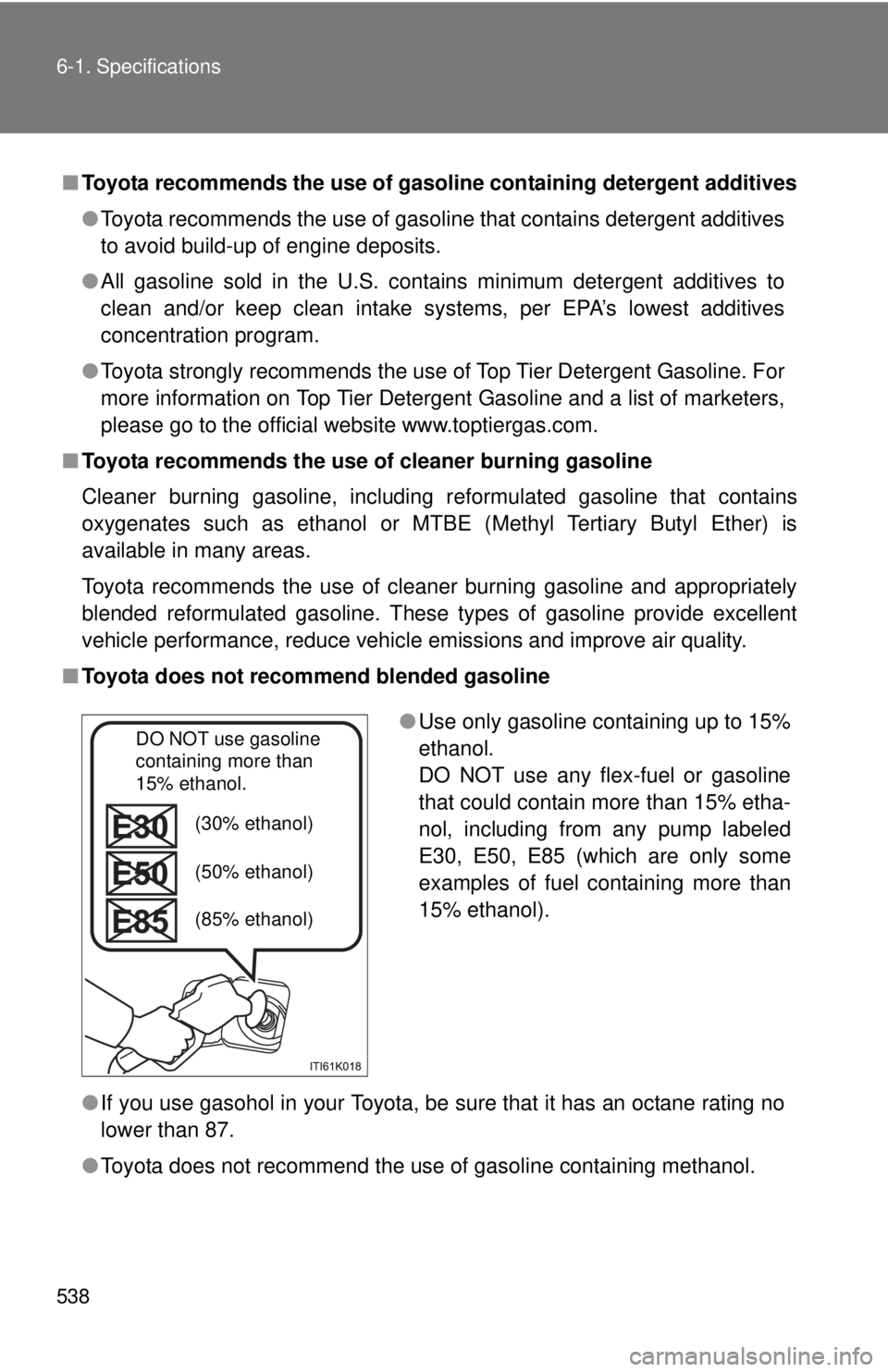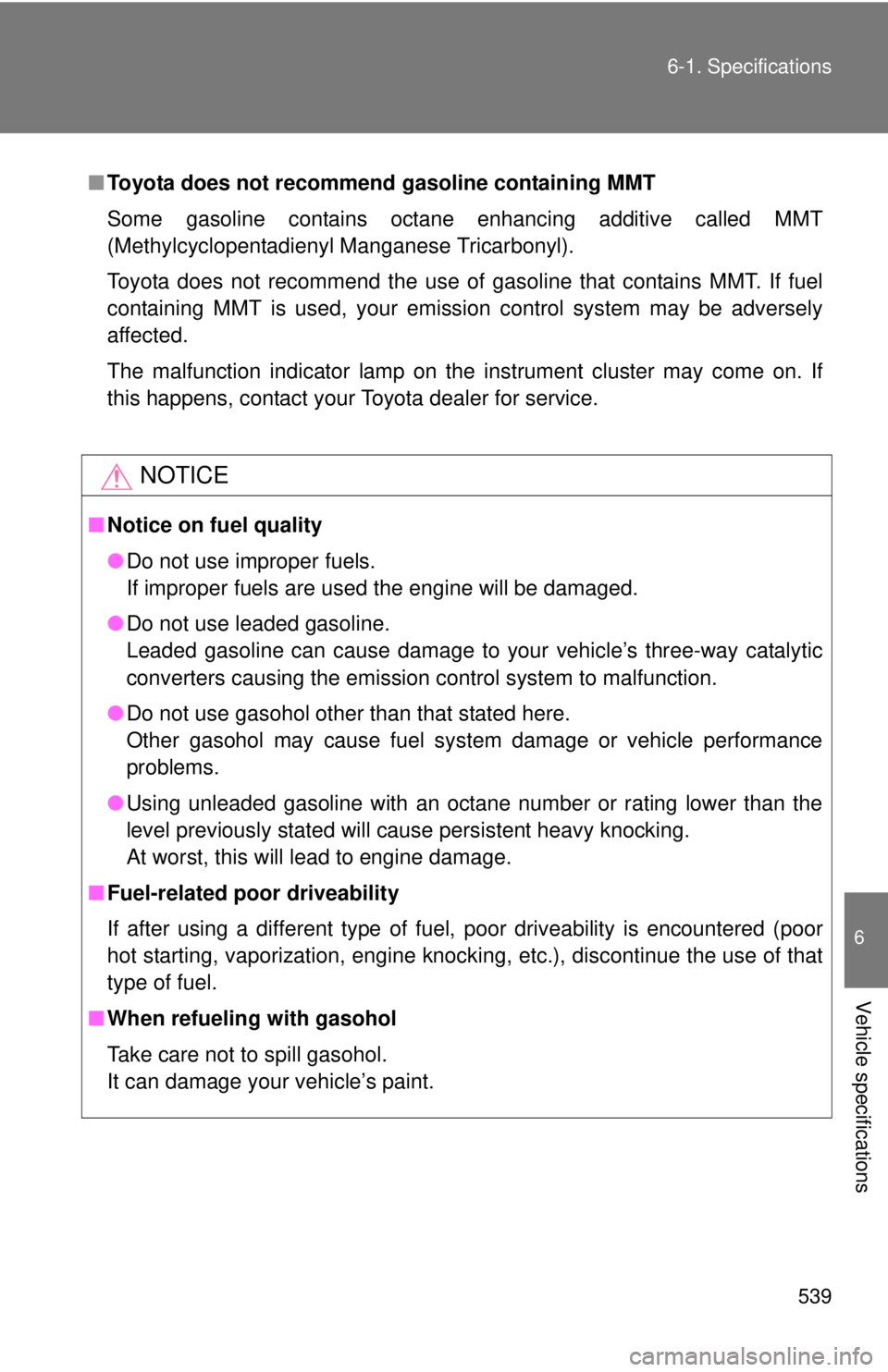Page 75 of 590

75
1-5. Refueling
1
Before driving
Closing the fuel tank cap
When replacing the fuel tank
cap, turn it until a clicking sound
is heard.
After releasing your hand, the cap
will turn slightly to the opposite
direction.
■Fuel types
Use unleaded gasoline. (Octane Rating 87 [Research Octane Number 91] or
higher)
■ Fuel tank capacity
Approximately 21.1 gal. (80.0 L, 17.6 Imp.gal.)
CAUTION
■Refueling the vehicle
Observe the following precautions while refueling the vehicle.
Failure to do so, may result in death or serious injury.
●Touch the vehicle or some other metal surface to discharge any static
electricity.
Sparks resulting from discharging static electricity may cause the fuel
vapors to ignite.
● Always hold the grips on the fuel tank cap and turn it slowly to remove it.
A whooshing sound may be heard when the fuel tank cap is loosened.
Wait until the sound cannot be heard before fully removing the cap.
In hot weather, pressurized fuel may spray out of the filler neck and cause
injury.
● Do not allow anyone that has not discharged static electricity from their
bodies to come close to an open fuel tank.
Page 525 of 590
523
6-1. Specifications
6
Vehicle specifications
Engine
2.7 L 4-cylinder (2TR-FE) engine
4.0 L V6 (1GR-FE) engine
Fuel
Model 2TR-FE
Type 4-cylinder in line, 4-cycle, gasoline
Bore and stroke 3.74 3.74 in. (95.0 95.0 mm)
Displacement 164.3 cu.in. (2694 cm3)
Drive belt tension Automatic adjustment
Valve clearance
(engine cold)
Intake
Exhaust Automatic adjustment
Model
1GR-FE
Type 6-cylinder V type, 4-cycle, gasoline
Bore and stroke 3.70 3.74 in. (94.0 95.0 mm)
Displacement 241.4 cu.in. (3956 cm3)
Drive belt tension Automatic adjustment
Valve clearance
(engine cold)
Intake
Exhaust 0.006 0.010 in. (0.15 0.25 mm)
0.011 0.015 in. (0.29
0.39 mm)
Fuel type Unleaded gasoline only
Octane Rating 87 (Research Octane Number 91) or higher
Fuel tank capacity
(Reference)21.1 gal. (80.0 L, 17.6 lmp.gal.)
Page 539 of 590

537
6-1. Specifications
6
Vehicle specifications
Fuel infor mation
■Fuel tank opening fo r unleaded gasoline
To help prevent incorrect fueling, your Toyota has a fuel tank opening that
only accommodates the special nozzle on unleaded fuel pumps.
■ If your engine knocks
●Consult your Toyota dealer.
● You may occasionally notice light knocking for a short time while
accelerating or driving uphill. This is normal and there is no need for
concern.
■ Gasoline quality
In very few cases, driveability problems may be caused by the brand of
gasoline you are using. If driveability problems persist, try changing the
brand of gasoline. If this does not correct the problem, consult your Toyota
dealer.
■ Gasoline quality standards
●Automotive manufacturers in the US, Europe and Japan have developed
a specification for fuel quality called World-Wide Fuel Charter (WWFC)
that is expected to be applied worldwide.
● The WWFC consists of four categories that are based on required
emission levels. In the US, category 4 has been adopted.
● The WWFC improves air quality by lowering emissions in vehicle fleets,
and customer satisfaction through better performance.
Your vehicle must use only unleaded gasoline.
Select octane rating 87 (Research Octane Number 91) or higher. Use
of unleaded gasoline with an octane rating lower than 87 may result
in engine knocking. Persistent kno cking can lead to engine damage.
At minimum, the gasoline you use should meet the specifications
of ASTM D4814 in the U.S.A..
Page 540 of 590

538 6-1. Specifications
■Toyota recommends the use of gaso line containing detergent additives
● Toyota recommends the use of gasoline that contains detergent additives
to avoid build-up of engine deposits.
● All gasoline sold in the U.S. contains minimum detergent additives to
clean and/or keep clean intake systems, per EPA’s lowest additives
concentration program.
● Toyota strongly recommends the use of Top Tier Detergent Gasoline. For
more information on Top Tier Detergent Gasoline and a list of marketers,
please go to the official website www.toptiergas.com.
■ Toyota recommends the use of cleaner burning gasoline
Cleaner burning gasoline, including reformulated gasoline that contains
oxygenates such as ethanol or MTBE (Methyl Tertiary Butyl Ether) is
available in many areas.
Toyota recommends the use of cleaner burning gasoline and appropriately
blended reformulated gasoline. These types of gasoline provide excellent
vehicle performance, reduce vehicle emissions and improve air quality.
■ Toyota does not recomm end blended gasoline
● If you use gasohol in your Toyota, be sure that it has an octane rating no
lower than 87.
● Toyota does not recommend the use of gasoline containing methanol.
●Use only gasoline containing up to 15%
ethanol.
DO NOT use any flex-fuel or gasoline
that could contain more than 15% etha-
nol, including from any pump labeled
E30, E50, E85 (which are only some
examples of fuel containing more than
15% ethanol).DO NOT use gasoline
containing more than
15% ethanol.
(30% ethanol)
(50% ethanol)
(85% ethanol)
Page 541 of 590

539
6-1. Specifications
6
Vehicle specifications
■
Toyota does not recommend gasoline containing MMT
Some gasoline contains octane enhancing additive called MMT
(Methylcyclopentadienyl Manganese Tricarbonyl).
Toyota does not recommend the use of gasoline that contains MMT. If fuel
containing MMT is used, your emission control system may be adversely
affected.
The malfunction indicator lamp on the instrument cluster may come on. If
this happens, contact your Toyota dealer for service.
NOTICE
■Notice on fuel quality
●Do not use improper fuels.
If improper fuels are used the engine will be damaged.
● Do not use leaded gasoline.
Leaded gasoline can cause damage to your vehicle’s three-way catalytic
converters causing the emission control system to malfunction.
● Do not use gasohol other than that stated here.
Other gasohol may cause fuel system damage or vehicle performance
problems.
● Using unleaded gasoline with an octane number or rating lower than the
level previously stated will cause persistent heavy knocking.
At worst, this will lead to engine damage.
■ Fuel-related poor driveability
If after using a different type of fuel, poor driveability is encountered (poor
hot starting, vaporization, engine knocking, etc.), discontinue the use of that
type of fuel.
■ When refueling with gasohol
Take care not to spill gasohol.
It can damage your vehicle’s paint.
Page 590 of 590
588
GAS STATION INFORMATION
Auxiliary catch leverP. 404Fuel filler doorP. 7 4
Tire inflation pressure
P. 5 3 2
Hood lock release lever P. 4 0 4
Fuel tank capacity
(Reference) 21.1 gal. (80.0 L, 17.6 Imp.gal.)
Fuel typeUnleaded gasoline, Octane Rating 87
(Research Octane Number 91) or higher
Cold tire inflation
pressure
P. 5 3 2
Engine oil capacity
(Drain and refill
-reference) P. 5 2 4
Engine oil type
P. 525